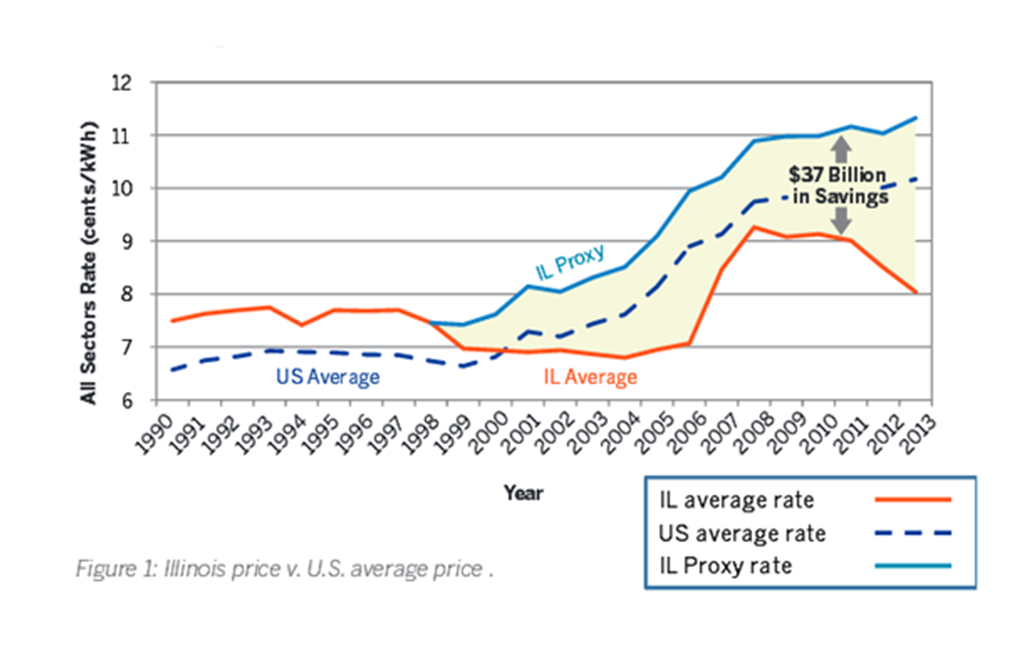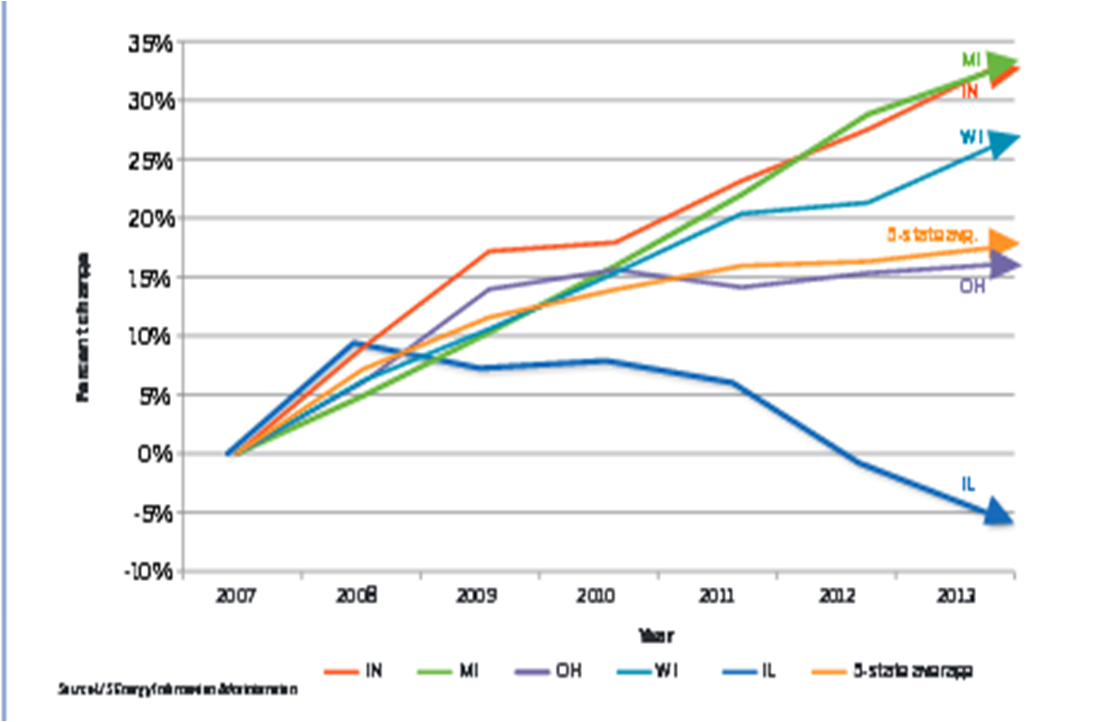Illinois: Electricity Price per Kilowatt-Hour Explained
The cost of electricity is calculated by multiplying the price per Kilowatt-Hour (kWh) by the amount of electricity consumed. But how is the price per kWh calculated? Though prices differ from one provider to the next, the average price per kWh in Illinois tends to evolve as a whole along with market changes.
How does Illinois Compare?
The average total cost per kWh in Illinois is below the national average, thanks to 1997 legislation which liberalized the market for electricity, according to the Illinois Chamber of Commerce, et al. The average price in Illinois is now around 11.7 cents per kWh according to NPR, ranking 32nd in the country.

Above: A comparison between average electricity prices per kWh in the US versus Illinois on the retail market. The Illinois proxy line estimates represents Illinois prices without deregulation.
What Makes Up the Price of Electricity per kWh in the State of Illinois?
In essence, three main charges determine the cost of electricity per kWh: Delivery, or Distribution; Supply; and Taxes.
Delivery Charges
Also known as distribution charges, these cover all the costs associated with delivering energy to a consumer's home or business. Delivery costs are regulated by the Federal Energy Regulatory Commission (FERC), and are the same whether you purchase electricity from your local utility or an alternative supplier.
These costs also energy generation, and transmission, or the delivery of energy from generators to the utility company. For Commonwealth Edison customers, this cost is the same across all service territory, while it varies based on location for Ameren Illinois customers. The Public Utility Commission of Illinois regulates the distribution and transmission portion of service delivery at the state level.
Supply Charges
Supply charges are based on the real market cost of electricity, and the amount used by the consumer. Various costs include "line loss" charges, which cover the heat lost when electricity travels across power lines to the consumer. MidAmerican Energy is the only provider in Illinois whose supply and distribution charges are entirely regulated, according to the Citizens Utility Board.
Traditionally, supply charges make up the largest proportion of your electricity cost per kWh. Below, see a breakdown of Ameren and ComEd's supply charges on fixed-rate plans.
Taxes
Electricity taxes are collected by the utility and ultimately transmitted to the government. Local taxes include the municipal tax, or the "local government compliance charge," which is regulated by the state government and stands at less than one cent per kWh.
State taxes are standard across Illinois, and are currently around 0.33 cents per kWh.
Miscellaneous Charges
Miscellaneous charges vary and can depend on your local community as well as electricity plan. For instance the environmental cost recovery charge is commonly included, to cover the cost of restoring land formerly used for energy production.
Some municipalities also charge a franchise cost from the utility, which gives the utility the right to distribute electricity to your area. The utility passes this cost on to consumers.
Other individual charges may vary by supplier.
Fixed-Rate Versus Variable-Rate Plans
Depending on provider availability, consumers may be able to choose between a fixed-rate or variable-rate electricity plan. There are relative advantages to both. In a fixed-rate plan, the price per kWh is fixed, usually based on the rate available at the beginning of the term, and remains the same until the end of the contract term. This protects consumers from fluctuations in the market cost of energy. For consumers under the more common variable price scheme, the price per kWh can change on a daily basis along with market prices. The advantage of this type of plan is that consumers benefit from drops in the price of energy, which are not reflected in fixed rate plans.
Another type of variable-rate plan is known as Time of Use Plans where prices vary according to the time of the day electricity is used, depending on peaks in demand.
Variations in Electricity Prices
Cost of Generation and Delivery
The cost of generating electricity can vary based on consumer demand. Increased consumption by consumers decreases available supply, thus driving up costs associated with generation.
Larger geopolitical factors can also affect the cost of generation, and infrastructural problems can impact delivery prices.
Weather
Weather has one of the most significant impacts on fluctuations in the cost of electricity. Summer is when costs notoriously rise, based on a higher demand for electricity in Illinois, mostly due to higher air conditioning use. Additionally, extreme weather events, which can cause downed power lines and damage to electricity generation systems, can lead to cost increases related to clean up.
Time of Day
In keeping with weather-related price changes, electricity rates can even change according to the time of day, as demand varies.
How Have Electricity Prices Changed Over Time in Illinois?
The cost of electricity in Illinois wasn't always below the national average, and in fact legislation has been a contributor to price fluctuations over time.
In the decades leading up to deregulation in 1997, Illinois regularly had the highest electricity prices in the region. Beginning in the 1970s, the cost of electricity skyrocketed in Illinois as demand declined and regulation worsened its effects. At the same time, the real cost of electricity was also rising.
Illinois pursued deregulation under the principle that open competition between suppliers could help deliver lower electricity prices. Price caps were instated a year later, in 1998, to help insulate consumers from any price changes associated with the transition. But when the caps and discounts expired in 2007, the cost of electricity spiked again to reflect real market costs.
Five-State Regional Comparison, 2007-2013.

Another round of consumer protections in 2007 brought prices back down, and since, prices in Illinois have remained relatively stable thanks to open competition. Now, the real cost of electricity and distribution are main factors in fluctuations in the cost per kWh in Illinois.
The Future for Prices per Kilowatt-Hour (kWh) in Illinois
Fluctuations in price per kWh are normal, although a combination of regulation and open competition have helped to protect Illinois residents from the price shocks of the past. These fluctuations generally affect the state or regions at-large since issues of consumption, weather, and legislation generally tend to affect broader regions of Illinois.
Luckily, utility companies which are able to cut down on costs will pass these savings on to consumers. Because many Illinois residents are free to switch to competitive suppliers, consumers help to push electric utilities to continue delivering competitive prices per kilowatt-hour.